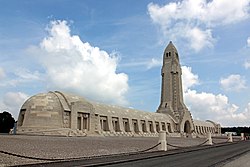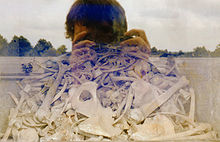Douaumont ossuary
| Ossuaire de Douaumont | ||
|---|---|---|
 Douaumont Ossuary, 2014 |
||
| Data | ||
| place | Fleury-devant-Douaumont | |
| architect | Léon Azéma | |
| Construction year | 1920-1932 | |
| height | 46 m | |
| Coordinates | 49 ° 12 '29 " N , 5 ° 25' 25" E | |
|
|
||
The Douaumont Ossuary (French Ossuaire de Douaumont ) is a French national burial site for the bones of the fallen who could not be identified after the Battle of Verdun . The ossuary ( ossuary ) is in the area of the former village of Douaumont . The bones of over 130,000 unidentified French and German soldiers are kept in it.
location
The facility is located on the Thiaumont Ridge, in the immediate vicinity of the former fortifications Ouvrage de Thiaumont , about one kilometer southwest of Fort Douaumont and about five kilometers northeast of the city center of Verdun . The place was chosen at the request of Marshal Pétain , as it was the place of the heaviest fighting, and because of its location on the hill, the ossuary can be seen from the entire former battlefield.
history
In 1920, Bishop Charles-Marie-André Ginisty visited the makeshift ossuary in which the fallen had been buried up until then. He decided to give the dead a more dignified burial ground and the bereaved a place to mourn. On August 22, 1920, Marshal Philippe Pétain was able to lay the foundation stone for the planned building. On September 18, 1927, the bones could be transferred from the temporary wooden building. The ossuary was officially inaugurated on August 7, 1932 by the French President Albert Lebrun . The chapel's first chaplain was Noël, a former military chaplain, and his grave is in the chapel.
In September 1984 the French President François Mitterrand and the German Chancellor Helmut Kohl met for a major reconciliation ceremony. The photo of the two politicians holding hands in front of the entrance to the ossuary went around the world. A commemorative plaque was installed in front of the ossuary to commemorate this meeting. It bears the following inscription:
-
On September 22, 1984, the French President and the German Chancellor met for the first time in the history of the two peoples at this French military cemetery. They laid wreaths to commemorate the dead of both world wars and declared:
- “We have made up. We have come to an understanding. We have become friends. "
- François Mitterrand and Helmut Kohl
On Sunday, February 9, 2014, the name of a German soldier, Peter Freundl (killed on May 28, 1916), was engraved on an arch of the ossuary for the first time.
Architecture of the ossuary
The building was designed by the architects Léon Azéma , Jacques Hardy and Max Edrei and officially inaugurated in 1932 after twelve years of construction.
On the outside of the impressive building are, among other things, the coats of arms of all cities that contributed money to the construction of the ossuary.
The interior of the 137 m long building forms a barrel vault with 46 side chambers. These side chambers (they stand for each main sector of the battlefield from Avocourt to Les Éparges ) each contain 2-3 granite tombs, in which the bones of a total of about 130,000 soldiers are located in the basement, who were mainly killed by explosive projectiles. In the hall there are memorial stones and tombstones for fallen French, whose names are known, as well as a chapel. A statue of the Madonna that was in the original ossuary, a simple wooden barracks, is now to the left of the entrance. In the tower there is a small museum and in the basement there is a room for film screenings and a souvenir shop. The ossuary chambers can be seen from the outside through window panes at the rear of the building.
According to one interpretation, the ossuary symbolizes a sword that is rammed into the earth up to the quillons , and from which only the handle (tower) rises. Alternatively, the tower can also be seen as a symbol of a grenade covered with crosses as a sign of peace.
The 46 m high, climbable Tour des morts (dt. Tower of the Dead) or La Lanterne des morts des ossuary contains a 2 ton bell, the Bourdon de la Victoire , which rings 3 times a day and on official occasions, as well as rotating spotlights lighting the battlefield at night. The tower was donated by the USA .
Outdoor area with war graves
In front of the ossuary there is a cemetery with 16,142 graves of French soldiers. It has an area of 144,380 m².
In addition to the fields with Christian crosses, there is a field with grave sites for Muslim fallen from the French colonies of the time, which are oriented towards Mecca . This was provided for in the planning.
Collective cemeteries around Verdun
A total of around 120,000 identified dead are buried in several collective cemeteries in the vicinity of Verdun. Around 10% of these dead were brought back home.
See also
Web links
- Official website of the Douaumont ossuary (fr, en, de)
- The national necropolis and the Douaumont ossuary. Ministère de la défense, accessed November 25, 2014 (French page is more extensive).
- GPS team project on the battlefields "Verdun - Somme - 1916" ( memento from July 19, 2011 in the Internet Archive ) with images from Google Earth, accessed on November 15, 2014
- Volksbund Deutsche Kriegsgräberfürsorge - Douaumont / Meuse
- Douaumont ossuary - status 09/2015 after the renovation carried out in 2012 , accessed on 25 May 2016.
- 125 photos of the ossuary on structurae.de , accessed on November 14, 2018.
- Design drawing in the National Library
- Entry on monumentum.fr
- Entry in Base Mérimée : 55000002
Individual evidence
- ↑ a b L'Atlas des Nécropoles. In: Ministère de la Defense. Retrieved November 22, 2014 .
- ↑ a b c Sandra Petermann: Rituals make spaces: For the collective commemoration of the Battle of Verdun and the landing in Normandy . transcript Verlag, 2015, ISBN 978-3-8394-0750-9 ( google.de [accessed June 23, 2020]).
- ^ Douaumont (Meuse) - Ossuary. Retrieved June 23, 2020 .
- ^ History of the Douaumont ossuary , official website verdun-douaumont.com
- ↑ a b Douaumont / Meuse war cemetery - construction, maintenance and repair | Volksbund.de. Accessed November 14, 2018 (German).
- ↑ The national necropolis and the Douaumont ossuary | Chemins de Mémoire - Ministère de la Defense. Retrieved November 14, 2018 .
- ^ Foundation German Historical Museum, Foundation House of the History of the Federal Republic of Germany: Just seen on LeMO: LeMO object: Photo Francois Mitterrand and Helmut Kohl in Verdun. Retrieved October 14, 2019 .
- ↑ spiegel.de: During the memorial ceremony
- ↑ Boileau, Grégory and André, Emmanuel: Douaumont: Peter Freundl, premier nom d'un soldat allemand gravé dans un mur de l'ossuaire. In: France 3. February 9, 2014, accessed November 14, 2014 .
- ↑ Struktura.de (accessed October 4, 2010) : Leon Azema
- ↑ Ossuary. In: verdun-douaumont. Accessed June 29, 2020 (German).
- ↑ historical postcard of the night view ( memento from April 1, 2016 in the Internet Archive )







